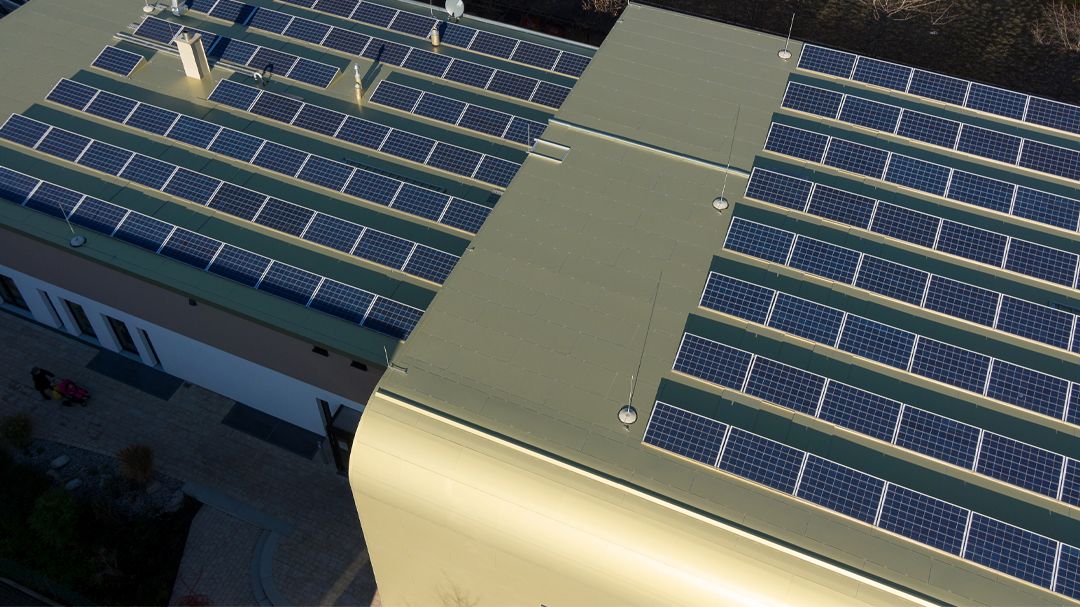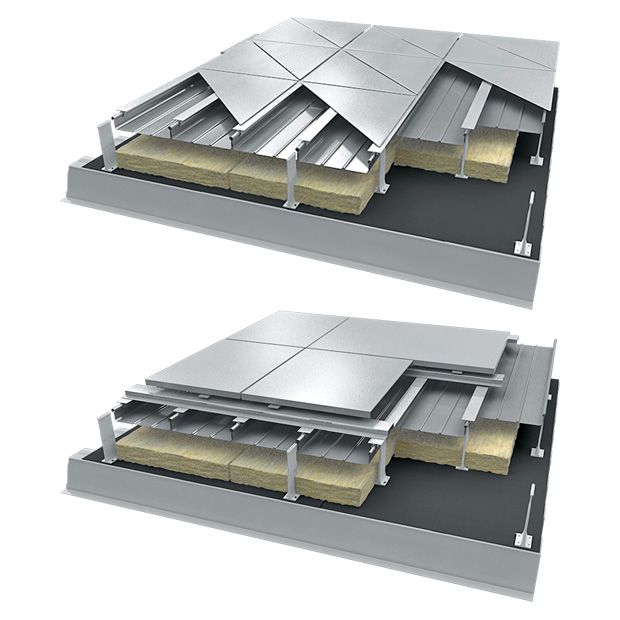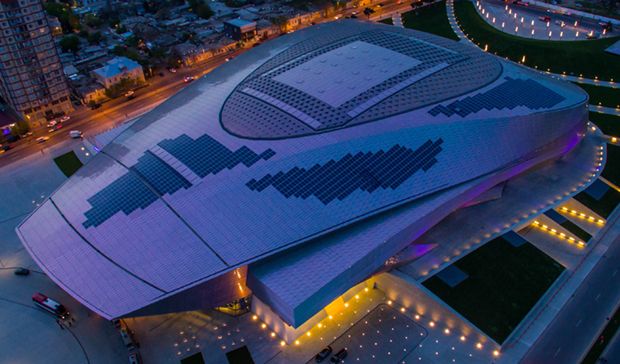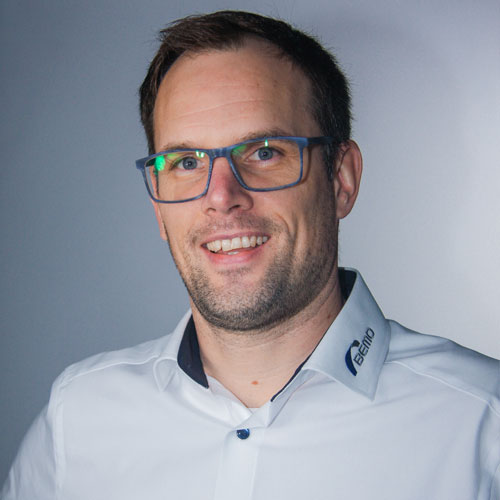Solar thermal system or photovoltaic modules for heating support – when it comes to renewable energies, the question is: What and how? Generating energy from sunlight via collectors on the roof has many advantages. When it comes to their own heating and/or power supply, many rely on solar thermal and photovoltaic solutions. For the installation of solar systems and photovoltaic modules – whether on-roof installation or in-roof installation – you need a suitable basis. Systems such as BEMO Smooth are ideal for this. Smooth and modern building shells with integrated solar or photovoltaic systems. In addition, there is the possibility of seamlessly designing the roof and facade. Modern and timeless design – BEMO-SMOOTH can be used in many different ways and makes the installation of the systems and solar modules a lot easier.
On-roof installation with BEMO Smooth: A standing seam system that can do more.
The name speaks for itself: The Smooth system is so called because the actual standing seam system is almost always used – but only technically and then covered with a smooth surface or cladding. This gives the building a different look, i.e. a different, special design. The technical strengths and the extremely durable standing seam system are used as a water-bearing layer. The building cladding is optical in nature and allows for any design – even timber is an option and has been proven on previous projects. In addition, solar thermal systems and photovoltaic modules can be easily and efficiently integrated or added as roof mounting. Design meets sustainability and durability.
What are the advantages and disadvantages of roof mounting?
On-roof installation initially promises more adaptability: The solar thermal system or photovoltaic modules are simply and inexpensively placed on the roof surface. This means that the solar collectors can be dismantled quickly and easily. At the same time, sufficient rear ventilation of the solar modules is guaranteed. However, the aesthetics of the attachment of the solar systems is often criticised. On top of that, solar collectors are better protected from the weather as they are installed in the roof. Both the integration of solar thermal and photovoltaics as well as roof mounting makes BEMO Smooth possible.
How is the roof mounted?
When installing the solar thermal and PV modules on the roof, a rail system is connected to the roof for attachment. The rails can run in a cross shape, vertically or horizontally. Rafter hooks are usually used to fasten the rails, i.e. hooks with a special shape made of aluminum or stainless steel that can be screwed onto the rafters. With the BEMO solutions, however, the modules can also be clamped on so that a screw connection can be avoided. A note: When installing photovoltaic modules or solar thermal systems on the roof, there should always be sufficient distance to the edge of the roof. This avoids a wind suction effect.
The connection between the roof profile (standing seam) and the design level: This is how it works!
The connection between the standing seam profile and the design level is formed by the TOP or AKKORD rail. The rail is closed like a standing seam and then serves as a substructure for the solar cladding or photovoltaic modules. The great advantages of the roof rails: the linear substructure, the quick and easy installation and the static capabilities, which, among other things, avoid point loads, as would be the case with individual clamps. In addition, there are no constraints and the roof system works permanently for decades.
Which superstructures are possible with on-roof installation?
Below the design and cladding level, almost any structure and any supporting structure can be implemented. The substrate can have timber, concrete, steel, load-bearing shell or mixed constructions. The right BEMO system can be found for every type of subsurface approved attachment. The innovative and passive house-certified GRP thermal holders are also used here, which have practically no thermal bridges. This makes it easy to achieve the passive house standard. In addition, the holders are the ideal complement to the basic idea of sustainable construction. The passive house-certified TEKOFIX A++ bracket, which meets the highest demands, can also be used in the façade. Soft insulation or rigid insulation form the insulation package. They insulate your roof and facade safely and for a long time. U-values of 0.15 W/m²*K and smaller are not a problem.
What cladding is possible?
In principle, every cladding design and every design surface is conceivable. Aluminum, aluminum composite panels, panels, perforated corrugated or trapezoidal profiles or HPL or other panel materials. Of course, any PV elements or solar thermal systems can also be used. Timber has also been used for this and used with open joints in the roof area. The water-bearing level is always below. The non-penetrative BEMO standing seam system fulfills this requirement in a long-lasting and permanent manner.
Advantages for builders: The roof-top solution can do this
The system not only offers efficiency and flexibility when it comes to installing solar and photovoltaic modules on the roof. What other advantages does it offer builders compared to other “on-roof solutions”? The services at a glance:
- Completely penetration-free installation in the water-bearing level
- The system is continuously mounted and without transverse joints
- PV modules or cladding are clamped on, which means that there are no fixing holes
- No additional loads are required, such as seals or a foil roof
The BEMO standing seam system is completely without penetrations in the water-bearing level and therefore offers high protection and stability for your building. Unlike screwed systems (sandwich or trapezoidal sheets) there is no weak point in the attachment. In addition, aluminum is used as a recyclable material, which can be reused during conversion or dismantling or returned to the cycle in high quality. Double added value and sustainable to the end – over many years. A roof system that also works perfectly without photovoltaics. Long panels (>100.00 m) and complex geometries are no problem.
What opportunities does the system offer accompanied by BEMO planners and architects?
Thanks to the simple and well-coordinated system solutions, the planner and the architect can adapt the design and layout at any time after the roof structure has been determined and the design is variable. The splints or a secondary layer form the basis for an individual design. In addition, BEMO offers support in every phase: design and rendering, feasibility and technical feasibility, cost estimation and tendering, assembly company and of course during implementation – we are always at your side. From the idea to the inauguration. Just contact us!










